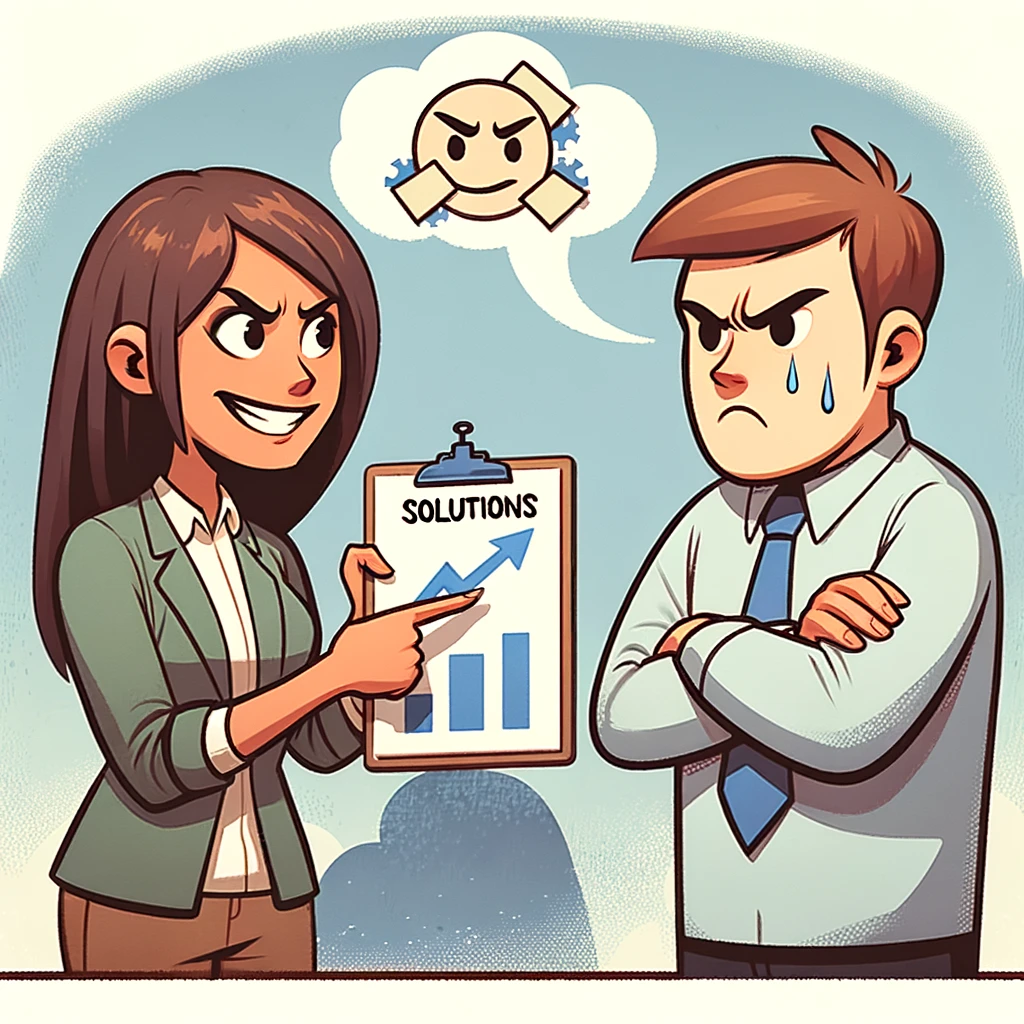Estimated reading time: 8 mins
Handling indignant individuals is a complex and nuanced challenge that we often encounter in both personal and professional contexts. Indignation, characterized by a strong sense of injustice and often manifested as anger or resentment, can lead to highly charged interactions. These situations require not only a keen understanding of human emotions but also a strategic approach to communication and conflict resolution. Learning to navigate these difficult encounters effectively is essential for maintaining harmonious relationships and fostering a positive environment. In this article, we will explore a structured process to help you manage and resolve interactions with indignant people more successfully.

1. Recognize the Signs of Indignant People
Identifying when someone is feeling indignant is a critical first step in addressing their concerns effectively. Indignant individuals often exhibit certain behaviors and physical signs that can alert you to their emotional state. These may include a noticeable change in tone, such as a shift towards a more aggressive or sarcastic manner of speaking. Physically, they might display signs of discomfort or agitation, such as pacing, tapping fingers, or a flushed face. Their body language can become closed off or confrontational, with crossed arms or a rigid posture. Verbally, they might express feelings of injustice or unfairness, often focusing on a specific incident or general treatment they perceive as wrong. Being able to spot these signs early gives you the opportunity to prepare and respond appropriately, setting the stage for a more constructive interaction.
2. Stay Calm and Composed in the Face of Indignant People


In the face of indignation, it’s essential to maintain your own calm and composure. This can be challenging, especially if the other person’s emotions are intense. Start by taking deep, controlled breaths to center yourself. Speak in a calm, steady voice, and maintain a neutral facial expression. Avoid mirroring their agitation; instead, be the calming influence in the interaction. Remember that staying composed doesn’t mean being passive—it’s an active choice to not let the situation escalate. Your calmness can act as a stabilizing force, setting a more constructive tone for the conversation. This approach helps prevent the situation from escalating and demonstrates your commitment to a respectful, productive dialogue.
3. Listen Actively and Empathetically
Active and empathetic listening is pivotal when dealing with an indignant person. This involves more than just hearing their words; it’s about truly understanding the emotions and intentions behind what they are saying. Show engagement by maintaining eye contact, nodding, and using affirmative responses like “I see” or “I understand.” Allow them to express their feelings without interruption, as cutting them off can escalate their indignation. By giving them the space to vent, you convey respect and concern for their feelings. This approach can significantly lower their defensiveness and open the door to a more constructive dialogue. Remember, sometimes people just need to feel heard and validated to start moving towards a resolution.
4. Acknowledge Their Feelings
Acknowledging the feelings of an indignant person is a crucial step in resolving conflicts. It involves more than just listening; it’s about validating their emotions. When you say something like, “I can see why this upset you,” or “It’s understandable that this situation frustrated you,” you are not agreeing with their stance but recognizing their right to feel aggrieved. This recognition can be incredibly powerful. It helps in de-escalating the emotional intensity of the situation and paves the way for a more rational dialogue. Remember, acknowledging someone’s feelings doesn’t mean you are conceding to their point of view; it simply shows that you respect them as an individual and are empathetic to their emotional state. This approach can transform a potentially hostile encounter into a constructive conversation, where solutions can be sought with mutual respect.
5. Seek to Understand Their Perspective
Asking questions to delve deeper into the reasons behind their indignation is vital. Approach this with genuine curiosity rather than judgment. Inquire about specific events or actions that triggered their feelings. Phrases like “Can you tell me more about what happened?” or “What specifically led you to feel this way?” can be helpful. This step is not about agreeing with their perspective but about showing that you value their viewpoint. By understanding the root of their emotions, you can better address the issue. Avoid making assumptions or immediately offering solutions, as this can sometimes be perceived as dismissive of their feelings. Active engagement in this part of the conversation demonstrates your commitment to resolving the conflict and can pave the way for a more constructive dialogue.
6. Remain Non-Defensive


When confronted with an indignant person, it’s natural to feel the urge to defend yourself, especially if their anger seems misplaced or exaggerated. However, adopting a defensive stance often escalates the conflict, making resolution more difficult. Instead, focus on maintaining a neutral, understanding tone. Acknowledge their feelings without necessarily agreeing with their accusations. Use phrases like, “I understand why you might feel that way,” to convey empathy without conceding fault. This approach helps to keep the conversation constructive, allowing you to address the real issues at hand without getting sidetracked by a cycle of blame and defensiveness. By staying non-defensive, you open up a space for dialogue and problem-solving, which is crucial for resolving situations fueled by indignation.
7. Set Boundaries if Necessary
Setting boundaries is essential when interacting with an indignant person, particularly if their behavior becomes abusive or excessively aggressive. It is crucial to do this politely but firmly. You might say, “I understand you’re upset, but I can’t engage in this conversation if it continues in a disrespectful manner.” This approach respects both parties’ dignity. It makes it clear that while you are open to dialogue and finding a solution, there is a limit to what behavior is acceptable. Establishing such boundaries not only protects your well-being but also models healthy communication practices, which can help de-escalate the situation.


8. Find Common Ground with Indignant People
Identifying areas of agreement with an indignant person can significantly shift the conversation’s dynamic. This approach involves actively listening for aspects of their argument that you can genuinely agree with or understand. It might be acknowledging a shared value, a mutual goal, or even agreeing on the importance of the issue at hand. By highlighting these points of convergence, you create a foundation for collaboration rather than conflict. This step doesn’t mean you agree with their every point, but it demonstrates a willingness to find a mutually beneficial resolution. It helps in steering the conversation towards a more constructive and less confrontational path.
9. Offer Solutions or Compromises
Once you’ve gained a clear understanding of their perspective and identified areas of common ground, the next step is to offer solutions or compromises. This should be done thoughtfully, ensuring that the solutions are both realistic and equitable. Articulate how these solutions can effectively address the concerns raised, benefiting all involved parties. It’s important to frame your suggestions in a way that shows you value their input and are genuinely interested in finding a resolution. Be open to their feedback on your proposals, as this can lead to a mutually agreeable and sustainable solution. Remember, the aim is to turn a confrontational situation into a collaborative problem-solving opportunity.


10. Take Responsibility if Appropriate
If the indignant reaction is a result of an error or oversight on your part, it’s crucial to acknowledge and take responsibility for it. A sincere apology can go a long way in diffusing tension. Explain clearly what happened and why, and more importantly, outline the steps you intend to take to rectify the mistake. This shows accountability and a commitment to making things right. Offer a clear plan for how you will prevent similar issues in the future. Taking responsibility can transform a potentially negative interaction into an opportunity for building trust and credibility.
11. Follow Up with Indignant People
Follow Up: Effective follow-up is crucial after an interaction with an indignant person, especially when solutions or compromises have been agreed upon. This step demonstrates your commitment to not only resolving the immediate issue but also to maintaining a positive, ongoing relationship. Reach out to the individual after a suitable period to inquire if the solution implemented is working for them. Ask for feedback and be open to further discussion if necessary. This follow-up can reassure the person that their concerns were taken seriously and can help in preventing similar issues in the future. It’s a vital part of building trust and ensuring lasting resolution.
12. Reflect and Learn


Reflecting on your interaction with an indignant person is an essential step in personal and professional development. Consider the conversation in detail: what triggered the person’s indignation, how you responded, and what the outcome was. Think about the effectiveness of your communication strategies – were you able to de-escalate the situation effectively? Did you manage to communicate your perspective without aggravating the person further? Identify any areas for improvement, such as ways to maintain composure under pressure or techniques to better acknowledge and validate feelings. Use these insights to enhance your skills in managing similar situations in the future.
Indignant People: Conclusion
In conclusion, dealing with indignant people requires patience, empathy, and a structured approach. By recognizing the signs of indignation, staying calm, actively listening, acknowledging feelings, understanding their perspective, remaining non-defensive, setting boundaries, finding common ground, offering solutions, taking responsibility when needed, following up, and reflecting on the experience, you can effectively manage these challenging interactions. Remember, the goal is not just to diffuse the immediate situation but also to maintain a respectful and productive relationship moving forward.
